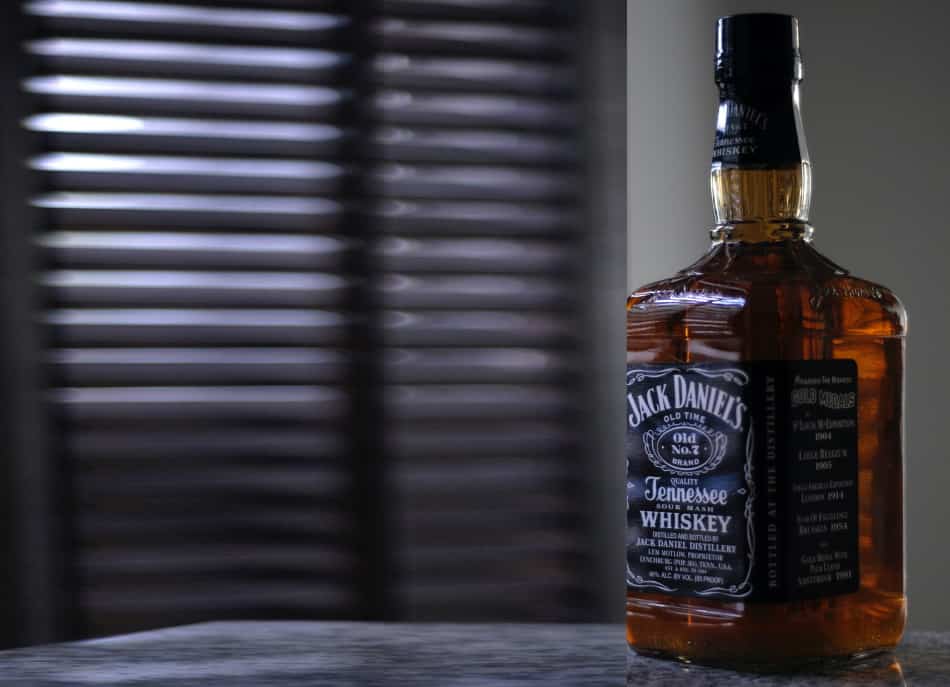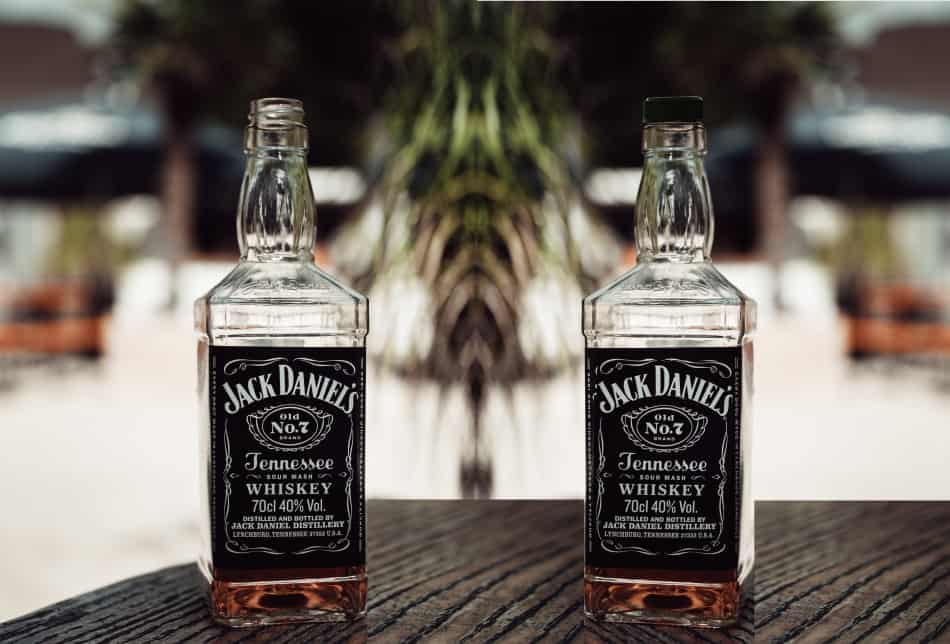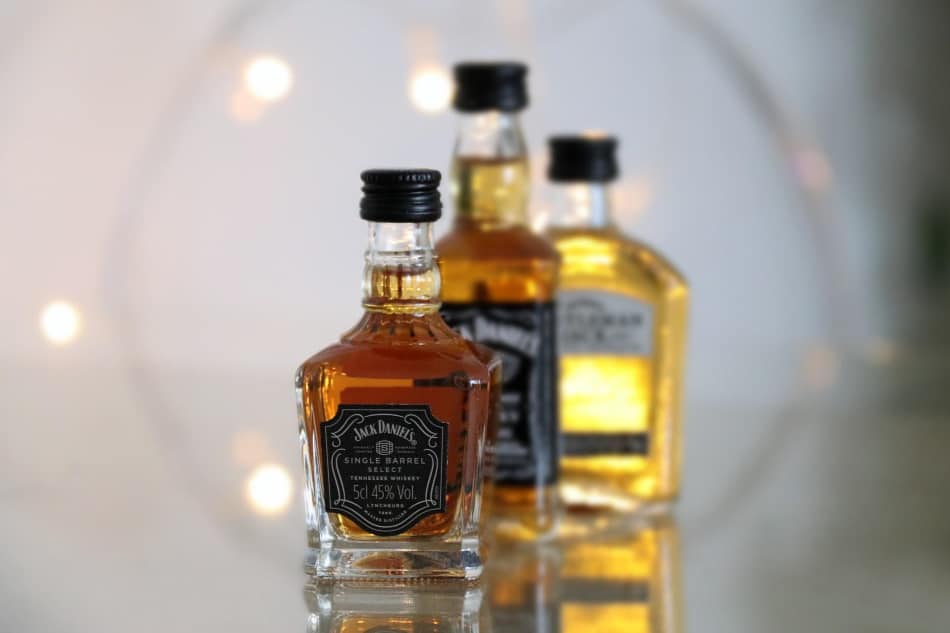Whether you have opened bottles of whiskey, sealed bottles of whiskey or a valuable whiskey collection, you’ll want to keep everything in good condition and protect your whiskey from going bad or becoming damaged. To do that you’ll need to store your whiskey properly. Here’s how.
1. Away From Direct Light and Direct Sunlight
All bottles of whiskey – open, sealed or a collection, should be stored somewhere it won’t be exposed to direct light or direct sunlight as they can ruin its color, flavor, label and packaging.
That’s because direct light and (worse) direct sunlight creates a chemical reaction in the volatile compounds of the whiskey which causes them to break down. Whiskey stored for long periods of time in direct light or direct sunlight will therefore degrade in one or two months, causing it to taste much harsher, possibly even of rubber, paint thinner or rotten fruit.
Additionally, the sun’s ultraviolet rays will bleach out the color pigments of the whiskey and over time discolor it. In other words, the beautiful golden color of your whiskey will become dull. And for those who have a whiskey collection, direct light and direct sunlight will also cause the label and parts of any packaging to fade.

2. In A Dry, Non-Humid Environment
It’s also important to store your whiskey in a dry, non-humid environment. That’s because although the humidity won’t harm the whiskey itself, it can have a significant effect on the exterior of the bottle and parts of any packaging. Humidity can damage the label and make it moldy. It can also damage any outer layers of boxing and packaging, making it more fragile and easier to tear.
If you’re still worried about humidity damaging the label or packaging, especially if the whiskey you’re storing is valuable or part of a collection, then you can keep your whiskey in an airtight plastic bag. Make sure the bag doesn’t contain any plasticisers or other chemicals as they could bleach the packaging or label and affect the contents of the bottle via the cork.
3. In A Cool Temperature
All bottles of whiskey should be stored in a cool temperature. 15°-20°C or 59°-68°F is best. That’s because heat causes the whiskey to evaporate faster and oxidize sooner.
Whiskey is always evaporating – even from unopened bottles as many seals are not 100% airtight, but the process is usually quite slow. So slow in fact, that if you’re only storing your whiskey for a few years the amount lost to evaporation will not be noticeable or worth doing anything about. However, if you store your whiskey in a hot temperature, it will obviously evaporate faster than usual.
Heat will also cause whiskey to oxidize sooner. Oxidation is when oxygen binds to one chemical compound and turns it into another, and in whiskey that means binding to one flavor compound and turning it into another. This doesn’t mean your whiskey’s gone bad – it’s still drinkable, but it does mean that it won’t taste the way it’s supposed to, so it’s certainly something to be avoided.
Oxidation starts as soon as your whiskey becomes exposed to air – which is usually when you first open the bottle, but it doesn’t change the flavors of your whiskey immediately. That usually takes anywhere from six months to two years depending on how much air gets into the bottle.
However, if you store your whiskey in a hot temperature it will oxidize sooner. That’s because whiskey expands when it becomes hot which in a fuller bottle brings it into contact with the cork. Whiskey has a high alcohol content level (between 40% – 68%ABV) which is more than enough to damage any cork that it’s in prolonged contact with.
And a damaged cork means a looser cork that lets more air into the bottle, which speeds up the process of oxidation.
Having said this, you shouldn’t store your whiskey in a cold environment like the fridge or freezer as lower temperatures can mute the aromas and flavors of your whiskey and cause it to go cloudy. Fortunately, the problems of lower temperatures are not as bad as the problems of higher temperatures as they can be reversed. When whiskey is warmed up to room temperature the aromas and flavors will return, and the cloudiness will disappear.
4. In A Stable Environment
Whiskey should be stored in a stable environment where the temperature doesn’t fluctuate too much. That’s because with every temperature fluctuation oxygen can flow into the bottle and speed up the process of oxidation.
5. Tightly Sealed

All bottles of whiskey should be stored tightly sealed. That’s because a looser seal also causes the whiskey to evaporate faster and oxidize sooner as more air can enter the bottle and more whiskey can leave.
For opened bottles of whiskey this means keeping the lid closed as tightly as possible. This won’t completely stop air getting into the bottle because you’re not making the seal airtight – you do want to open the bottle regularly after all, but it will ensure that the process of oxidation doesn’t happen sooner than it otherwise would, and that less whiskey evaporates.
If your bottle has a twist on lid then you should retighten it regularly as they often become loose on their own. If the original cork does not seal your bottle well, buy a poly seal cap that will seal the bottle better. You can find poly seal caps on Amazon here . Just make sure to get the best fit for your particular bottle.
. Just make sure to get the best fit for your particular bottle.
For unopened bottles of whiskey, you’ll need to add an additional seal. This is necessary because as mentioned, many seals are not 100% airtight so small amounts of air can still get into the bottle and over the years you’re storing it, can add up to enough to oxidize your whiskey. The minimal amount of whiskey that evaporates also adds up with time. After a decade evaporation will become noticeable, and after 30 – 40 years it will be significant.
The additional seal can be an extra cap on top of the lid or cork or made by dipping your bottle in wax. However, these methods can damage the bottle and the underlying seal, and so are not the best solutions, especially if the whiskey is valuable.
A better solution is to use parafilm. This is a film made from a blend of waxes and polyolefins that’s semi-transparent and flexible. It’s malleable, non-toxic, tasteless, odorless, and self-sealing. You can wrap it around the lid making it airtight and it won’t harm the underlying seal. The only downside is that after some time it becomes brittle and less effective, so it needs replacing every five to seven years.
(Do not apply parafilm to wax dipped bottles as that’s redundant and the film will meld with the wax making it impossible to remove after a while.)
You can buy All Purpose Laboratory Parafilm on Amazon here (affiliate link).
(affiliate link).
6. With Minimal Headspace
Opened bottles of whiskey should be stored with minimal headspace – the empty space in your bottle between the cork or lid and the whiskey that’s actually air. That’s because the more headspace, the more air will get to your whiskey and the sooner it will oxidize.
For opened bottles of whiskey this becomes more of a problem as time goes on because you’re drinking the whiskey which automatically increases the amount of headspace in the bottle. When there’s only an inch or two of headspace there won’t be much effect on the whiskey’s flavors for at least a year, but when three quarters of the bottle is air, the quality of the whiskey inside will degrade in about a month.
The solution to this is to transfer your whiskey into a smaller bottle where the headspace will be far less. Of course, this is only a temporary solution as you’re still drinking your whiskey, so after some time there will be too much headspace in the new bottle too. You can repeatedly transfer your whiskey into progressively smaller bottles, but at some stage the best solution will be to finish your whiskey as soon as possible.
7. Upright But Turned Over Every So Often

All bottles of whiskey that are sealed with a cork should be stored standing up. That’s because storing them lying down would put your high ABV whiskey in constant contact with the cork which as mentioned would damage it, causing the seal to loosen, air to seep in and your whiskey to oxidize sooner.
On the other hand, corks that are kept completely dry for long periods of time may chip or crumble, which also means a looser seal, air seeping in and your whiskey oxidizing sooner. In many cases the alcohol vapors evaporating through the cork will keep it moist but it’s still a good idea to turn your bottles over in case that’s not enough. You can either:
- Rest your whiskey bottles horizontally for an hour or so once or twice a year.
- Turn your whiskey bottles upside down for a few seconds once a month.
That way the whiskey won’t damage the cork and the cork won’t dry out.
8. Somewhere It Won’t Be Easily Damaged or Stolen
Valuable bottles of whiskey should be stored somewhere they won’t be easily damaged or stolen. This also means storing your whiskey carefully to avoid rips, scuffs, and dents to the labels, boxes and packaging. It’s a good idea to keep your bottles packed in the cartons or cases they came in. Make sure your inventory and appraisal are up to date.
Depending on how valuable your collection is you may want to think about storing your whiskey in a locked cabinet, safe or even vault with a good alarm system. You may even need to consider using a secure location outside your home.
9. Get An Insurance Policy
Get an insurance policy for valuable bottles of whiskey because your whiskey collection is no different to any other valuable items that require insurance from damage and theft.
10. With Flair
Unless your whiskey collection is in a cellar or under lock and key, your whiskey bottles should be stored in a way that, while keeping all the above rules, still allows them to be displayed with flare – as befits such an important drink.
How you do this will depend on your personal taste and your situation, but it could be a stylish decanter, a display shelf, a liquor dispenser, a drinks cabinet or even a whiskey barrel.
I put together a few ideas which you can find on Amazon here (affiliate link).
(affiliate link).

